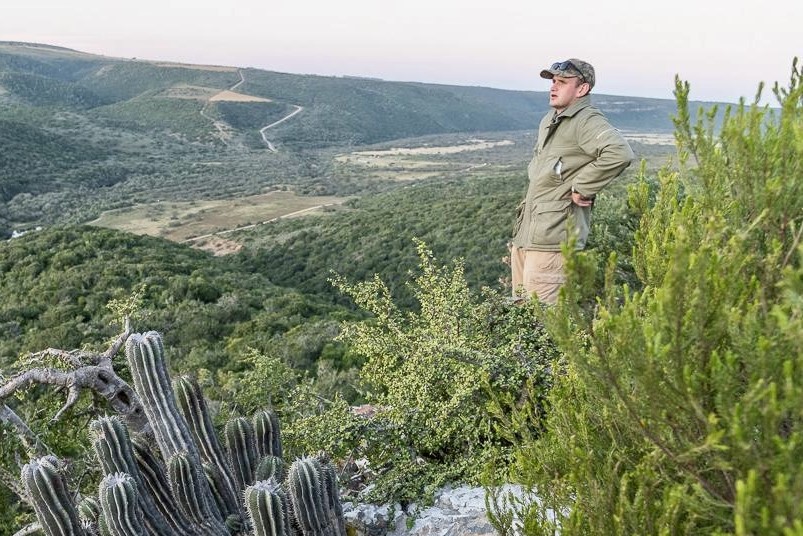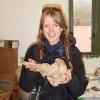With new technologies revolutionizing data collection, wildlife researchers are becoming increasingly able to collect data at much higher volumes than ever before. Now we are facing the challenges of putting this information to use, bringing the science of big data into the conservation arena. With the help of machine learning tools, this area holds immense potential for conservation practices. The applications range from online trafficking alerts to species-specific early warning systems to efficient movement and biodiversity monitoring and beyond.
However, the process of building effective machine learning tools depends upon large amounts of standardized training data, and conservationists currently lack an established system for standardization. How to best develop such a system and incentivize data sharing are questions at the forefront of this work. There are currently multiple AI-based conservation initiatives, including Wildlife Insights and WildBook, that are pioneering applications on this front.
This group is the perfect place to ask all your AI-related questions, no matter your skill level or previous familiarity! You'll find resources, meet other members with similar questions and experts who can answer them, and engage in exciting collaborative opportunities together.
Just getting started with AI in conservation? Check out our introduction tutorial, How Do I Train My First Machine Learning Model? with Daniel Situnayake, and our Virtual Meetup on Big Data. If you're coming from the more technical side of AI/ML, Sara Beery runs an AI for Conservation slack channel that might be of interest. Message her for an invite.
Header Image: Dr Claire Burke / @CBurkeSci

Explore the Basics: AI
Understanding the possibilities for incorporating new technology into your work can feel overwhelming. With so many tools available, so many resources to keep up with, and so many innovative projects happening around the world and in our community, it's easy to lose sight of how and why these new technologies matter, and how they can be practically applied to your projects.
Machine learning has huge potential in conservation tech, and its applications are growing every day! But the tradeoff of that potential is a big learning curve - or so it seems to those starting out with this powerful tool!
To help you explore the potential of AI (and prepare for some of our upcoming AI-themed events!), we've compiled simple, key resources, conversations, and videos to highlight the possibilities:
Three Resources for Beginners:
- Everything I know about Machine Learning and Camera Traps, Dan Morris | Resource library, camera traps, machine learning
- Using Computer Vision to Protect Endangered Species, Kasim Rafiq | Machine learning, data analysis, big cats
- Resource: WildID | WildID
Three Forum Threads for Beginners:
- I made an open-source tool to help you sort camera trap images | Petar Gyurov, Camera Traps
- Batch / Automated Cloud Processing | Chris Nicolas, Acoustic Monitoring
- Looking for help with camera trapping for Jaguars: Software for species ID and database building | Carmina Gutierrez, AI for Conservation
Three Tutorials for Beginners:
- How do I get started using machine learning for my camera traps? | Sara Beery, Tech Tutors
- How do I train my first machine learning model? | Daniel Situnayake, Tech Tutors
- Big Data in Conservation | Dave Thau, Dan Morris, Sarah Davidson, Virtual Meetups
Want to know more about AI, or have your specific machine learning questions answered by experts in the WILDLABS community? Make sure you join the conversation in our AI for Conservation group!
Ranger Campus
- 0 Resources
- 3 Discussions
- 6 Groups
- @womble
- | he/him
AI Researcher, with 30+ years experience in academia and industry. Currently consulting for a company using drone imagery to analyse property heat loss. Expertise in machine learning, NLP, python, Google Cloud. https://julianrichardson.net
- 0 Resources
- 6 Discussions
- 6 Groups
- 0 Resources
- 0 Discussions
- 2 Groups
I am a herpetologist interested in bioacoustics, evolution and conservation biology. Currently, I am a postdoc fellow at Universidade Federal de Santa Maria (UFSM), Brazil.
- 0 Resources
- 0 Discussions
- 5 Groups
- @Harsha
- | He/Him
I am a marine biologist / acoustic ecologist from Australia. Fascinated by bioacoustics, I always look forward to learning from people in conservation!
- 0 Resources
- 0 Discussions
- 11 Groups
- 0 Resources
- 3 Discussions
- 8 Groups
Holder of BSc in Applied Zoology. Assistant Ecologist at Ruaha National park.


- 0 Resources
- 7 Discussions
- 12 Groups
University of Zurich
PhD student at the University of Zürich (CH) in PopEcol group, working with camera traps and mammals
- 0 Resources
- 0 Discussions
- 8 Groups
- @fsattar
- | Farook
Farook Sattar received his Technical Licentiate and PhD degrees from Lund University, Sweden. He obtained his B.Eng and M.Eng degrees from Bangladesh University of Engineering & Technology (BUET), Dhaka in Electrical and Electronics Engineering.
- 0 Resources
- 0 Discussions
- 2 Groups
- @LucyD
- | She/Her
Software developer and wildlife ecologist

- 0 Resources
- 2 Discussions
- 5 Groups
- @sroilo
- | she/her
- 0 Resources
- 0 Discussions
- 4 Groups
- @nabilla.nuril
- | She/Her
University College London (UCL)
- 0 Resources
- 0 Discussions
- 11 Groups
Microbial fuel cells, developed by Plant-powered Camera Trap Challenge winners Plant-E, have been used successfully with Xnor.ai's energy harvesting camera technology to capture what are thought to be the world's first...
15 October 2019
In a first, UMass Amherst, Cornell use AI to mine big migration data on massive scale
9 October 2019
Rutgers University, Microsoft AI for Earth, Google Earth Outreach and San Diego Zoo Global are proud to announce the world’s first camera trap technology symposium, to take place November 7th and 8th at Google...
2 September 2019
Sharing failure, tech support for conservation, roaming mentors, conservation tech hype cycles and developing new road maps - participants in our tech workshops at ICCB 2019 shared an abundance of ideas for how to shape...
21 August 2019
In this case study, Cooper Oelrichs of Save Indonesian Endangered Species Fund (SIES) breaks down his proposal for the development and training of an automated rhino identification system from limited camera trap data.
27 July 2019
The WILDLABS TECH HUB is supporting technology solutions tackling the illegal wildlife trade, in collaboration with the Foreign & Commonwealth Office, Digital Catapult, Satellite Applications Catapult, Amazon Web...
4 June 2019
To further their missions, LDF and Microsoft are collaborating on the AI for Earth innovation grant to support applicants in creating and deploying open source machine learning models, algorithms, and data sets that...
4 June 2019
Traditionally, illegal wildlife trade thrived in physical markets. But today it has also moved online. In China, more than half of the trade in elephant ivory items happens on e-commerce platforms. Enrico Di Minin and...
31 May 2019
This webinar recording will provide a brief overview of current SMART functionality, highlight case studies of large scale and innovative SMART deployments, and detail how SMART is embracing and leveraging new...
21 May 2019
In February, we released an open call for the WILDLABS TECH HUB, offering 3 months of support for solutions using technolgy to tackle the illegal wildlife trade. We were overwhelmed by an incredible 37 submissions,...
13 May 2019
To realise the potential benefits of data for our societies and economies we need trustworthy data stewardship. We need to establish different approaches to deciding who should have access to data, for what purposes and...
15 April 2019
Happy World Wildlife Day! To celebrate, this week we've asked our community to share photos showing how they are using tech in the field or the lab, using the #Tech4Wildlife hashtag.
3 March 2019
June 2025
event
July 2025
October 2025
event
event
November 2023
event
73 Products
Recently updated products
16 Products
Recently updated products
| Description | Activity | Replies | Groups | Updated |
|---|---|---|---|---|
| I added plain old motion detection because megadetector v5 was not working well with the smaller rat images and in thermal.This works really well: Also, I can see... |
|
AI for Conservation, Camera Traps | 4 months 3 weeks ago | |
| Hello WalterThanks for your input. I have achieved better results with the puc when hooking it up to a powerbank. Have got them set up to "recording only", and GPS to low power... |
|
Acoustics, AI for Conservation, Citizen Science, Sensors | 5 months ago | |
| great, this security cameras might be interesting for monitoring crop development and maybe other bigger pests like boars or some other herbivorous animals that could eventually... |
|
AI for Conservation, Camera Traps | 5 months 1 week ago | |
| In a recent call with researchers in Thailand. They have mentioned that they use passive chip readers to log data about chipped animals as they pass by. |
+12
|
AI for Conservation, Animal Movement | 5 months 1 week ago | |
| Seems like we should include some rotations in our image augmentations as the real world can be seen a bit tilted - as this cropped corner view from our fisheye at the zoo shows. |
+13
|
AI for Conservation, Camera Traps, Data management and processing tools | 5 months 2 weeks ago | |
| Bird Monitoring Data Exchange is a standard often used for birds data. |
+4
|
AI for Conservation, Data management and processing tools, Emerging Tech | 5 months 3 weeks ago | |
| Hey everyone!As you might have heard, BlueSky is on hype now, with millions of users migrating to it from X. Including the scientific world... |
|
AI for Conservation | 5 months 4 weeks ago | |
| Hi Zhongqi! We are finalizing our modelling work over the next couple of weeks and can make our work availabile for your team. Our objective is to create small (<500k... |
|
AI for Conservation, Camera Traps, Software Development | 6 months ago | |
| Hats off to your team for this absolute game-changing technology! We rescue stray and wild animals in Taiwan, and the bulk of our work is saving animals maimed by wire snares... |
+37
|
AI for Conservation, Drones, Emerging Tech, Human-Wildlife Conflict, Wildlife Crime | 6 months ago | |
| There's quite a few diy or prototype solutions described online and in literature - but it seems none of these have made it to market yet as generally available fully usable... |
|
AI for Conservation, Camera Traps, Human-Wildlife Conflict, Sensors | 6 months ago | |
| As others have said, pretty much all image models at least start with general-subject datasets ("car," "bird," "person", etc.) and have to be refined to work with more precision... |
+20
|
AI for Conservation, Camera Traps | 6 months 1 week ago | |
| This is a thread for anyone who has questions about AI for Conservation Office Hours 2025.We're once again teaming up with Dan Morris from... |
|
Acoustics, AI for Conservation, Camera Traps, Community Base, Geospatial | 6 months 1 week ago |
Introductions
10 December 2015 8:13pm
17 January 2016 9:08pm
Hi,
I am jason Holmberg from WildMe.org. I am one of the developers of Wildbook (wildbook.org), an open source data management platform for wildlife research. I'm using ML as part of the IBEIS.org project to boost and metascore multiple computer vision algorithms for individual humpback and sperm whales. David, I would love to speak offline if you have the time: jason@wildme.org.
Cheers,
Jason
Google Releases Tensor Flow
18 November 2015 12:10am
20 December 2015 7:05pm
"TensorFlow, you see, deals in a form of AI called deep learning. With deep learning, you teach systems to perform tasks such as recognizing images, identifying spoken words, and even understanding natural language by feeding data into vast neural networks. "
Would this be applicable to an acoustic monitoring network? For example. my research has shown tigers have unique, identifiable vocalizations down to the individual and sex. If this software is applied to my recording network for tigers, would it be able to automatically recognize and categorize these individuals?
For example: when it hears Tiger 108, it would know and then input that it heard Tiger 108 at a particular time and date.
11 January 2016 12:38pm
The catch will be (and for any neural network or AI type learning I would expect the same) the training phase. If you are able to tell the sounds apart or identify a specific sound as belonging to a certain individual, the AI should afterwards be able to automatically identify the critical factors needed to distinguish the voices of the individuals. But it will need enough input from each individual as well as the different vocalizations used by tigers. AFAIKT it will be able to do this automatically afterwards, but I am not sure if (a) you will get enough identifiable vocalisations and (b) with a wide enough range of typical tiger vocalisations for it to be really reliable. Training on zoo animals might work? I am also interested in this, but for jackals instead of tigers.
11 January 2016 2:30pm
I'd like to suggest our open source package Wildbook (http://www.wildbook.org) as a base data management platfor for this. I agree with the above that there are a number of challenges around the vocalizations themselves, but having the identity information in a good database and data model is a great foundation. That's what we're doing for our computer vision/deep learning project at www.IBEIS.org.
Our non-profit WildMe.org is running both. Feel free to contact us with questions. We have played with time series matching (often used for speech recognition)...but actually for whale flukes. Would be happy to discuss potential for audio ID.
Deep Learning Image Recognition of Species In Global Wildlife Crime Reporting
31 December 2015 7:28pm
Big Data and Conservation: Deluge or Drought?
22 December 2015 12:00am
Cheap Space, DIY Imaging and Big Data
21 December 2015 12:00am
The Impact of the Internet of Things
10 December 2015 12:00am
Harnessing Big Data to Combat Illegal Wildlife, Timber and Fisheries Trade
 Rachel Kramer
and 2 more
Rachel Kramer
and 2 more
26 November 2015 12:00am
Technology for Traceability
 Daniel Brizuela
and 1 more
Daniel Brizuela
and 1 more
26 November 2015 12:00am
From Data Collection to Decisions
6 November 2015 12:00am
The Social Lives of Conservation Technologies and Why They Matter
2 November 2015 12:00am



















































10 December 2015 8:41pm
To start things off...
I'm David J Klein. My background is in deep learning, machine learning, neuroscience, neuromorphic computing, and signal processing. I've been doing the startup thing Silicon Valley for the last 11 years after being in academia for a while. I've worked on products ranging from speech recognition systems, to cloud-based deep learning platforms. These days, some use the blanket term "AI".
For the last several years I've been developing software for Conservation Metrics which gives their analysists the ability to use deep learning to process large volumes of audio and image data from remote sensors in order to monitor population density changes of endangered species, detect collisions of birds and bats with infrastructure, and find rare and elusive species.
More broadly, I'm interested in integrating many disparate sensing domains from eDNA, to land-based sensors, to GIS data in order to provide tools to conservation scientists and ecologists that will enable them to develop a higher resolution understanding of the health of ecosysems around the globe and their response to positive or negative human interventions.
I'm looking forward to interacting with you all. Please let me know what other questions you have for me, and other ways I can help.
Regards,
David